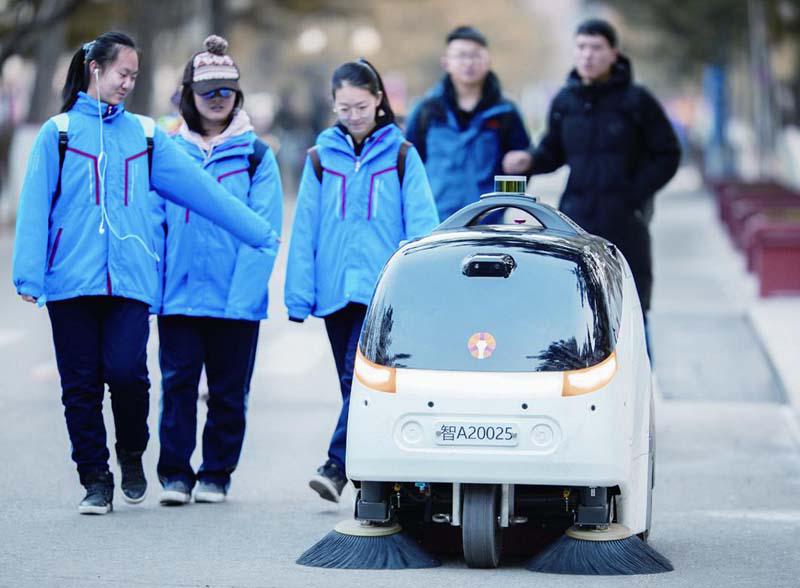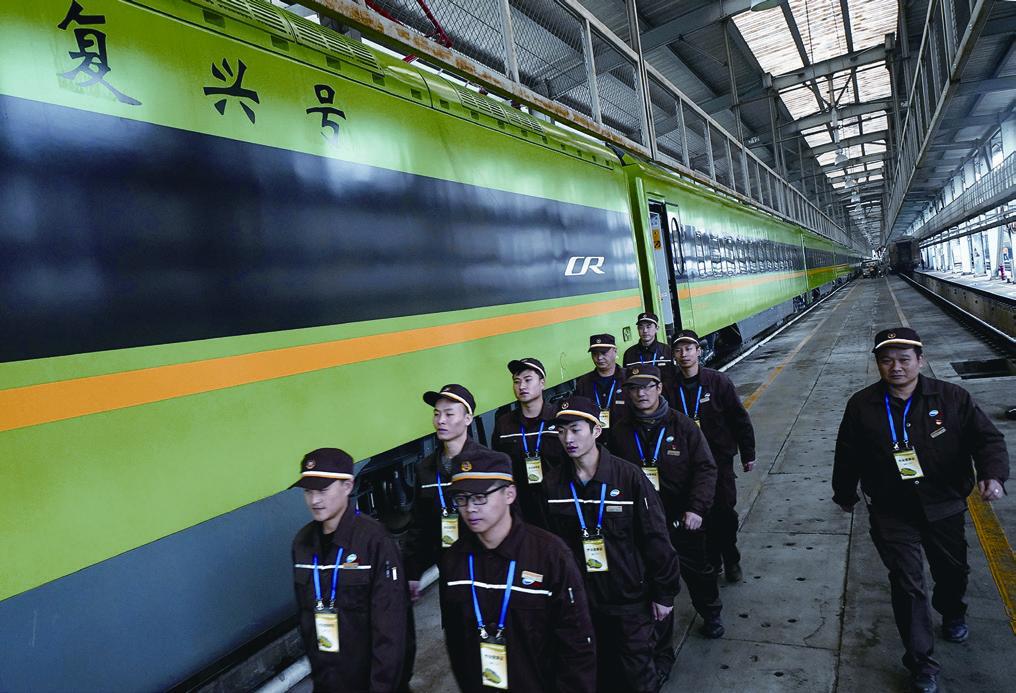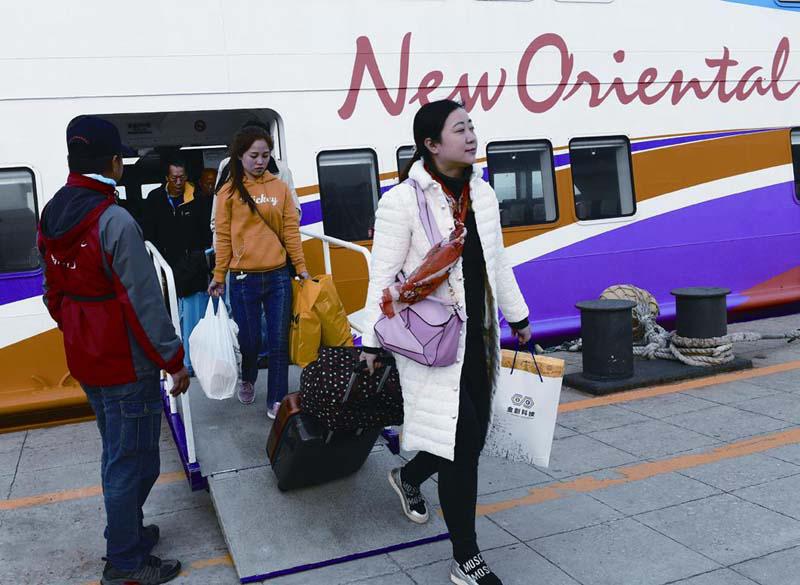Joy in Winter
2019-02-13

A giant panda named Yashuang plays at a wild animal zoo in Jinan, capital city of east Chinas Shandong Province, on January 6.
Earth Simulation
The construction of an earth simulation platform is underway in Beijing, authorities said on January 8.
The construction started in Miyun District in August 2018, offi cials said at this years local Peoples Congress of the district.
Quantitative descriptions and simulations will be carried out with the platform, which can help deepen the understanding of the evolution of the atmosphere, hydrosphere, cryosphere, lithosphere and biosphere and the interaction among them, said Zhu Jiang, head of the Institute of Atmospheric Physics of the Chinese Academy of Sciences.
A number of innovation and research platforms on the environment and ecology, climate change and resource detection will also be built in the district.
Gun Crimes Drop
China had 42 gun crimes and 39 explosive-related crimes from January to November in 2018, down 27.6 and 29 percent, respectively, year on year, according to the countrys Ministry of Public Security(MPS) on January 8.
The numbers put China on the list of countries with the fewest gun and explosive-related crimes in the world, the ministry said at a press briefi ng.
During the same period, Chinese police cracked over 37,000 cases related to guns and explosives, busting 416 gangs and 599 dens, and arresting 43,000 suspects.
More than 12,000 shotguns, 42,000 air rifl es, 38,000 powder guns and 54,000 other guns were confi scated, along with 3.69 million bullets, 416 tons of dynamite and 500,000 detonators, according to the ministry.
The crackdown launched early in 2018 was highlighted as a national campaign, making the action more targeted and effective, said Guo Lin, a spokesperson for the MPS.
Since the start of the campaign, authorities across the country have received over 5,000 tips from the public related to gun and explosiverelated crimes, based on which more than 2,200 cases were handled and 3.65 million yuan ($533,800) in rewards cashed, Guo said.
Invention Patents
The number of new invention patents registered on the Chinese mainland increased by 18 percent in 2018, according to a meeting of the heads of intellectual property rights(IPR) administrations on January 7.
By the end of 2018, there were about 1.6 million invention patents from the Chinese mainland, rising 18.1 percent year on year. The number of valid registrations of trademarks reached 18.05 million, up 32.8 percent.
In 2018, 31,000 trademark violation cases, with a total value of 550 million yuan ($80.3 million), were investigated. A total of 510 million yuan ($74.6 million) was confi scated in fi nes.
Chief of the State Administration for Market Regulation Zhang Mao said IPR are playing an increasingly prominent role in the countrys economic and social development.
Zhang called for improved IPR review effi ciency, reinforced IPR protection and enhanced international competitiveness and infl uence.
Air Quality
The air quality in 338 Chinese cities improved in 2018, the Ministry of Ecology and Environment said on January 7.
The cities enjoyed good air quality on 79.3 percent of days in 2018, up 1.3 percentage points year on year, meeting the air quality target for the year, according to the ministry.
In the Beijing-Tianjin-Hebei region, the share of days with good air quality stood at 50.5 percent, a year-on-year increase of 1.2 percentage points, while the PM 2.5 density of the region dropped by 11.8 percent year on year to 60 micrograms per cubic meter.
The Yangtze River Delta area saw its share of good air quality days increase by 2.5 percentage points to 74.1 percent, while the PM 2.5 density dropped by 10.2 percent to 44 micrograms per cubic meter.
Harbin and Changchun in northeast China were among the cities that had major air quality improvements in 2018.
China released a three-year action plan on air pollution control in 2018, vowing to cut emissions of sulfur dioxide and nitrogen oxide by more than 15 percent by 2020 compared with 2015 levels.
Meanwhile, cities at the prefecture level and above should see their numbers of good air days reach 80 percent annually and the percentage of heavily polluted days decrease by more than 25 percent from 2015 levels, according to the plan.
Population Decline
A new report predicts that China will see a population decline around 2028, Beijing Youth Daily reported on January 4.
Since 2010, the number of Chinese people 65 years old and above has increased by 83.2 million, with an average annual growth of 2.08 million. However, the population under the age of 15 has decreased by 90.17 million, with an average reduction of 2.25 million per year, said the report released on January 3 by the Institute of Population and Labor Economics under the Chinese Academy of Social Sciences in Beijing.
China is aging rapidly, with its aging population increasing from 3.76 percent to 8.4 percent since 2010, and the countrys total population will begin to show a negative growth rate around 2028, according to the report.
However, data shows that the number of newborn second children rose signifi cantly in 2016 and 2017, accounting for 51.2 percent of all newborns. A total of 8.83 million babies born in 2017 have an older sibling, an increase of 1.62 million, or 11 percentage points from 2016.
The report also said that China would have a shrinking labor population. In 2017, the countrys working-age population (16 to 64) declined by 5.78 million.
The negative growth of the labor force will bring structural changes to the supply-demand relationship of the labor market and create urgent requirements for the reform of related systems, said the report.
Robotic Road Sweeper
An automated road sweeper is tested at Inner Mongolia Normal University in Hohhot, north Chinas Inner Mongolia Autonomous Region, on January 9.
Civil Aviation
Chinas civil aviation regulator said on January 7 that the country aims to expand its fi xed-asset investment in the civil aviation sector to 85 billion yuan ($12.4 billion) in 2019.
This is compared to 81 billion yuan ($11.8 billion) invested in 2018, according to the Civil Aviation Administration of China (CAAC).
The total transport turnover of the countrys civil aviation industry is expected to increase 11.8 percent year on year to 136 billion ton-kilometers in 2019, said Feng Zhenglin, head of the CAAC, at a work conference.
Cargo and mail transport volumes are likely to increase 11 percent and 5.7 percent, respectively, in 2019, in addition to passenger transport volume, according to the CAAC.
Feng said the civil aviation industry made remarkable achievements in 2018, with the total transport turnover up 11.4 percent year on year to 120.64 billion tonkilometers.
In 2018, 167 new international fl ight routes were launched, with 105 of them linking domestic cities with countries along the Belt and Road, taking the number of Chinas total fl ight routes to 4,206.
Efforts will be made to push forward the construction of Beijings new international airport and ensure its opening to air traffi c at the end of September 2019, Feng said.
He added that as of the end of 2018, 55.49 billion yuan($8.17 billion) had been invested in the Beijing Daxing International Airport. The new airport is expected to handle 45 million passengers annually by 2021 and 72 million by 2025.
Peak Season Readiness
Workers check a CR200J train at the China Railway Shanghai Group Co. Ltd. in Shanghai on January 6. With a centralized power system that runs 160 km per hour, the train will be put into use before the Spring Festival travel rush.
Commodity Options
Options contracts for rubber, cotton, and corn will be launched on January 28, Chinas top securities regulator said on January 4.
The China Securities Regulatory Commission (CSRC) has given the nod to start rubber options on the Shanghai Futures Exchange, cotton options on the Zhengzhou Commodity Exchange and corn options on the Dalian Commodity Exchange as part of the governments drive to promote more complex agricultural trading tools.
Options give the holder the right to buy or sell a commodity at a particular strike price and allow greater hedging fl exibility for Chinese processors and traders.
Spot commodity prices of rubber, cotton and corn have seen frequent fl uctuations in recent years, and the trading of related options will help fi rms manage risks in an individualized and sophisticated manner, said CSRC spokesperson Gao Li.
It will also help reduce insurance costs for farmers and better serve the vitalization of rural areas, Gao added.
China launched soymeal options on March 31, 2017, the countrys fi rst exchange-traded commodity options product.
New Heights
Workers conduct quality inspection on the worlds highest steel pylon in Zhoushan, east Chinas Zhejiang Province, on January 3. The 380-meter-high pylon is part of a large power transmission project in Zhoushan.
Consumption Boost
China will introduce incentives to support consumption in key areas while increasing effective investment as part of its efforts to shore up the economy, the countrys top economic planner said on January 7.
“We will keep the economy operating within a reasonable range for 2019 while striving for a good start in the fi rst quarter,”Ning Jizhe, Vice Minister of the National Development and Reform Commission, said.
The country should tap into its consumption potential by pushing reforms in the income distribution system and increasing the income of low-paid groups. At the same time, it will increase effective investment in key areas including relocation programs for the poor and major infrastructure projects, according to Ning.
China will also step up efforts to push the implementation of key foreign investment projects. While the fi rst group of such projects, including the new plant of U.S. electric carmaker Tesla in Shanghai, has seen notable progress, the country will advance the second group, which will focus on new energy.
Ning said the country will help ease the fi nancing strain on private companies, with incentives to encourage high-quality fi rms to raise funds through issuing bonds.
Coal Railway
A new railway for coal transportation has opened in north China, according to China Railway Taiyuan Group.
The railway runs 214 km between Shuozhou in Shanxi Province and Jungar in neighboring Inner Mongolia Autonomous Region.
It is designed to have an annual transport capability of 5.26 million tons to serve as a major coal outlet for mineral-rich Inner Mongolia.
The Shuozhou-Jungar railway is a vital part of north Chinas railway network transporting coal and will offer new opportunities for local industries, said an offi cial with China Railway Taiyuan Group.
Smartphone Sales
Chinas smartphone shipments fell 15.5 percent last year to 390 million units, data from the China Academy of Information and Communications Technology (CAICT) showed on January 8.
In December 2018, smartphone shipments reached 33.5 million units, down 17 percent year on year, according to a report from the CAICT, a research institute under the Ministry of Industry and Information Technology.
Smartphones accounted for 94.1 percent of all mobile phone shipments in the country in 2018.
Overall mobile phone shipments dropped 15.6 percent in 2018 to 414 million units, of which 391 million were 4G phones.
Chinese-brand mobile phones accounted for 89.5 percent of total shipments last year, according to the report.
All-Time High
Passengers arrive at Wutong Port in Xiamen, southeast Chinas Fujian Province, on January 8. In 2018, ferry services between Xiamen and Kinmen in Taiwan carried more than 1.74 million travelers, a record high since the route was launched in 2001.
Green Investment
Data from the National Bureau of Statistics showed investment in Chinas environmental sector surged 42 percent year on year in the fi rst 11 months of 2018, up 5.3 percentage points from the January-October period.
China National Machinery Industry Corp. Ltd. (Sinomach), a state-owned machinery conglomerate, is targeting green areas such as the production of equipment related with environmental protection and core components of new-energy vehicles, according to Sinomach General Manager Zhang Xiaolun.
“I believe green manufacturing will accelerate the transformation and upgrading of Chinas manufacturing industry, improve its core competency and facilitate its sustainable development,” he told a recent forum.
Energy enterprises are also on the move. As China begins exploiting its abundant geothermal resources and clean and sustainable energy, Sinopec Green Energy Geothermal Development Co. Ltd. is expanding its services in the countrys urban and rural areas.
The company now provides geothermal heating for an area of around 50 square km, and it aims to increase the area by 100 square km by 2023, according to Chen Menghui, Deputy General Manager of the company.
Export Cooperation
The Rwanda Development Board(RDB) and Chinas e-commerce giant Alibaba will seek to support Rwandan entrepreneurs by exporting products such as beef, crayfi sh, avocado, chili peppers, French beans, tree tomatoes, and other fruits and vegetables to China.
They will achieve this by providing the necessary infrastructure to boost agro-processing, lowering the cost of air-freight transport and providing more training to Rwandan entrepreneurs to enable them to increase capacity and means, according to a statement released by the RDB after representatives of the two sides met in the Rwandan capital of Kigali on January 6.
China presents a huge market for Rwanda, with its large population and increasing spending power, RDB CEO Claire Akamanzi said. The RDB is exploring “unique and big”opportunities in the Chinese market, she added.
A Hopeful Start
A Tesla Model 3 is displayed at the groundbreaking ceremony of Tesla Shanghai gigafactory on January 7. The new plant, Teslas fi rst outside the United States, has an annual production capacity of 500,000 electric cars.
Land-Sea Corridor
Eight provincial-level regions in west China signed a framework agreement on January 7 to build a new international land-sea trade corridor. The eight regions include Chongqing Municipality, the prov- inces of Guizhou, Gansu, Qinghai and Yunnan, as well as Guangxi Zhuang, Xinjiang Uygur and Ningxia Hui autonomous regions.
The new corridor is an international trade and logistics passage jointly built by the Chinese regions and ASEAN countries under the framework of the China-Singapore(Chongqing) Demonstration Initiative on Strategic Connectivity.
Taking advantage of various transport options including railways, highways and water and air routes, the corridor enables transportation from west China to access more regions across the world.
The corridor was renamed in November 2018 from the previous China-Singapore Southern Transport Corridor launched in 2017. Initially, only Chongqing, Guangxi, Guizhou and Gansu signed the agreement in August 2017. Then, in June and November 2018, Qinghai and Xinjiang joined the project.
